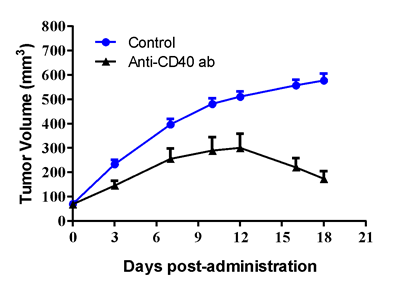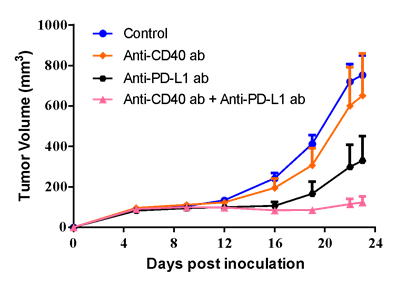Based on the co-inoculated model, LIDE can provide in vitro induction using monocytes isolated from the same donor with huPBMC into dendritic cells (DCs), and co-inoculation using CD3+ T cells isolated from activated huPBMC, induced DCs, as well as cancer cells for immunotherapy.

Flowchart of huPBMC+DCs+cancer cells co-inoculating model
 |
 |
| Raji human Burkitt's lymphoma were seeded in cultural dish, while human PBMC from a healthy volunteer was isolated and co-cultured with Raji. Monocytes isolated from PBMC of the same donor were induced in vitro to form DCs. Then CD3+ T cells isolated from activated huPBMC, induced DCs, and Raji cells were co-inoculated into the right flank in NCG mice. Mice were randomized when average tumor volume grown up to ~70 mm3 and dosing were initiated accordingly. Anti-CD40 ab was dosed at 7.5 μg/mouse through intratumorally. Dosing were performed bi-weekly for a total of 6 injections, while tumor volume and body weight were measured twice a week. |
A375 human melanoma cancer cells were seeded in cultural dish, while human PBMC from a healthy volunteer was isolated and co-cultured with A375. Monocytes isolated from PBMC of the same donor were induced in vitro to form DCs. Then CD3+ T cells isolated from activated huPBMC, induced DCs, and A375 cells were co-inoculated into the right flank in NCG mice. Mice were randomized right after tumor inoculation and dosing were initiated accordingly. Anti-CD40 ab was administrated at 3 mg/kg bi-weekly for 7 injections, whereas anti-PD-L1 ab was dosed at 1 mg/kg every other day for 12 injections. All dosing were performed via i.p. injection, while tumor volume and body weight were measured twice a week. |